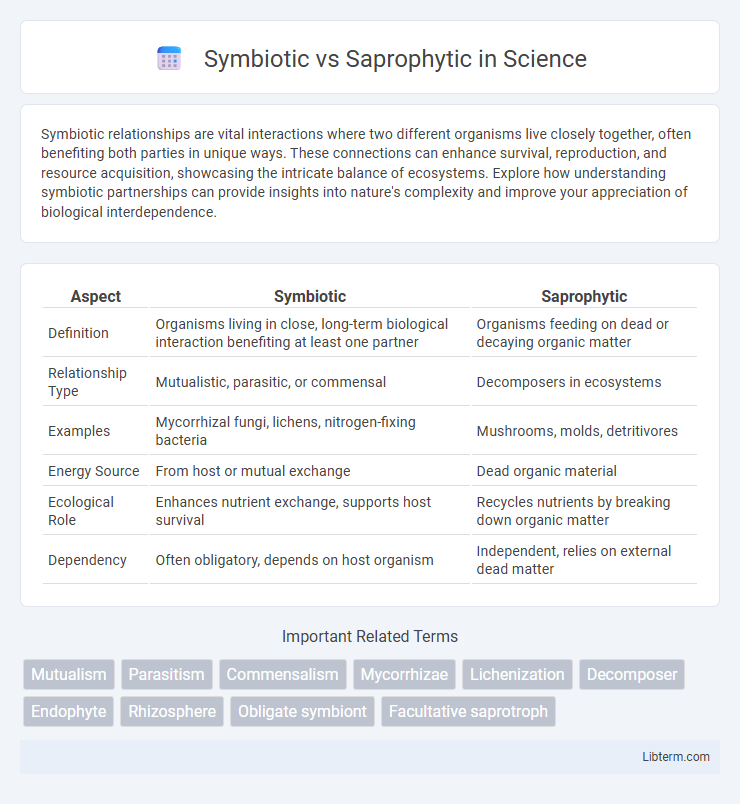Symbiotic relationships are vital interactions where two different organisms live closely together, often benefiting both parties in unique ways. These connections can enhance survival, reproduction, and resource acquisition, showcasing the intricate balance of ecosystems. Explore how understanding symbiotic partnerships can provide insights into nature's complexity and improve your appreciation of biological interdependence.
Table of Comparison
| Aspect | Symbiotic | Saprophytic |
|---|---|---|
| Definition | Organisms living in close, long-term biological interaction benefiting at least one partner | Organisms feeding on dead or decaying organic matter |
| Relationship Type | Mutualistic, parasitic, or commensal | Decomposers in ecosystems |
| Examples | Mycorrhizal fungi, lichens, nitrogen-fixing bacteria | Mushrooms, molds, detritivores |
| Energy Source | From host or mutual exchange | Dead organic material |
| Ecological Role | Enhances nutrient exchange, supports host survival | Recycles nutrients by breaking down organic matter |
| Dependency | Often obligatory, depends on host organism | Independent, relies on external dead matter |
Introduction to Symbiotic and Saprophytic Relationships
Symbiotic relationships involve close and long-term interactions between different species where at least one organism benefits, such as mutualism, commensalism, and parasitism. Saprophytic relationships describe organisms, mainly fungi and bacteria, that obtain nutrients by decomposing dead organic matter, playing a crucial role in nutrient cycling. These interactions highlight fundamental ecological processes essential for ecosystem balance and organism survival.
Defining Symbiotic Associations
Symbiotic associations involve a mutually beneficial relationship between two different organisms living in close physical proximity, where both partners gain essential nutrients or protection. In contrast, saprophytic organisms derive nutrients solely by decomposing dead organic matter without interacting directly with living hosts. Understanding symbiotic associations is crucial in fields like ecology and agriculture, as these relationships enhance nutrient cycling, plant growth, and ecosystem stability.
Understanding Saprophytic Nutrition
Saprophytic nutrition involves organisms, primarily fungi and bacteria, obtaining nutrients by decomposing dead organic matter through extracellular enzymes that break down complex molecules into simpler substances. This mode of nutrition plays a vital ecological role in nutrient cycling and organic matter recycling within ecosystems. Unlike symbiotic relationships that require living hosts, saprophytes thrive independently on non-living organic material, facilitating decomposition and nutrient release.
Key Differences Between Symbiotic and Saprophytic Modes
Symbiotic organisms engage in mutually beneficial relationships with other living hosts, exchanging nutrients or support essential for survival, while saprophytic organisms derive nutrients exclusively from decomposing dead organic matter. Symbiosis is characterized by close, often long-term interactions involving live hosts, such as mycorrhizal fungi associating with plant roots, whereas saprophytes, like many fungi and bacteria, contribute to nutrient cycling by breaking down complex organic substances into simpler compounds. The key distinction lies in symbionts' dependence on living partners for growth, contrasting with saprophytes' reliance on non-living organic substrates.
Types of Symbiotic Interactions
Symbiotic interactions include mutualism, where both organisms benefit; commensalism, where one benefits without harming the other; and parasitism, where one organism benefits at the expense of the other. These interactions contrast with saprophytic relationships, in which organisms such as fungi and bacteria decompose dead organic matter, recycling nutrients in ecosystems. Understanding these types helps clarify ecological roles and energy flow in natural habitats.
Examples of Symbiotic Organisms
Examples of symbiotic organisms include the nitrogen-fixing bacteria Rhizobium, which live in root nodules of leguminous plants, providing them with essential nutrients while receiving carbohydrates in return. Mycorrhizal fungi form mutualistic relationships with plant roots, enhancing water and mineral absorption for the host plant in exchange for sugars. Coral reefs exemplify symbiosis as well, where coral polyps and photosynthetic zooxanthellae algae coexist, with algae supplying oxygen and nutrients through photosynthesis and corals offering protection and access to sunlight.
Examples of Saprophytic Organisms
Saprophytic organisms, such as fungi including mushrooms and molds, obtain nutrients by decomposing dead organic matter. Examples also include bacteria like Bacillus subtilis and Actinomycetes, which play essential roles in nutrient recycling in ecosystems. These saprophytes contribute significantly to soil fertility by breaking down complex organic materials into simpler compounds.
Ecological Roles and Importance
Symbiotic organisms engage in mutually beneficial relationships with their hosts, contributing to nutrient cycling, enhancing soil fertility, and supporting plant growth through nitrogen fixation or mycorrhizal associations. Saprophytic organisms decompose dead organic matter, playing a crucial role in nutrient recycling by breaking down complex compounds into simpler forms that enrich the soil. Both symbiotic and saprophytic interactions are essential for maintaining ecosystem balance, promoting biodiversity, and sustaining food webs.
Impact on Environmental Balance
Symbiotic relationships enhance environmental balance by promoting biodiversity and nutrient cycling through mutual interactions between organisms, such as nitrogen-fixing bacteria and plants. Saprophytic organisms contribute to ecosystem health by decomposing organic matter, recycling nutrients back into the soil, and supporting plant growth. Both symbiotic and saprophytic processes are essential in maintaining soil fertility, ecosystem productivity, and overall ecological stability.
Conclusion: Symbiotic vs Saprophytic—Which is More Essential?
Symbiotic relationships are more essential for ecosystem stability because they involve mutual benefits that enhance biodiversity and resource efficiency, such as nitrogen-fixing bacteria in plant roots. Saprophytic organisms play a crucial role in nutrient cycling by decomposing dead organic matter and returning nutrients to the soil, supporting overall ecosystem productivity. Both are indispensable, but symbiosis directly sustains living organisms while saprophytes maintain environmental balance through decomposition.
Symbiotic Infographic

 libterm.com
libterm.com